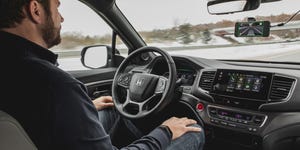- MIT researchers are working on a way for self-driving cars to scan the ground below the road and localize themselves through that information.
- The new technology could help autonomous vehicles navigate in bad weather, conditions where cameras and lidar struggle.
- While the technology is not road ready yet, it could be an important piece of making self-driving vehicles more viable for widespread use.
Although nobody is being shuttled around daily in a fully autonomous car (yet), the technology has progressed quickly and is showing up in one form or another in our daily drivers. Cadillac’s Super Cruise and Tesla’s Autopilot are some of the most advanced systems available. Nevertheless, the technology faces problems in inclement weather.
Self-driving vehicles, in conjunction with highly detailed maps, rely on cameras and lidar to navigate. The problem is that, in conditions such as rain, snow, fog, and so on, visibility decreases, and therefore, the effectiveness of those technologies diminishes.
Researchers at MIT’s Computer Science and Artificial Intelligence Lab (CSAIL) are working on a different approach to self-driving technology through looking below ground, not above. They’re calling on preexisting technology called localizing ground-penetrating radar (LGPR). Using it, the vehicle sends electric pulses through the ground to map the composition of the soil below the road.
The electric pulses create a sort of fingerprint of the ground, and then the vehicle can use that information to localize itself without cameras or lidar. The technology is especially useful when roads are covered in snow, which means cameras are unable to locate lane lines.
“Our work demonstrates that this approach is actually a practical way to help self-driving cars navigate poor weather without actually having to be able to ‘see’ in the traditional sense using laser scanners or cameras,” MIT professor Daniela Rus, a senior author on the forthcoming paper set to be published later this month, said in an article on the CSAIL website.
Maps of the ground, according to the researchers, can also be reliable for longer periods of time versus the typical above-ground maps, since the former change much more slowly. Nonetheless, the LGPR technology can’t be used on its own given the existence of above-ground hazards such as pedestrians, other cars, and various other obstacles.
The technology still has a way to go before it’s ready for people to start using out on the roads, but is another step in making autonomous technology viable for everyday use.
Source: Motor - aranddriver.com





